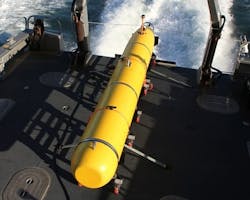Navy eyes sonar, communications, and power upgrades for Black Pearl unmanned underwater vehicles (UUVs)
Officials of the Naval Research Laboratory (NRL) at Stennis Space Center, Miss., issued a request for information on Tuesday (N00173-19-RFI-WR02) for the Unmanned Underwater Vehicles (UUVs) for Undersea Research project to upgrade the 21-inch-diameter Black Pearl UUV with new capabilities.
Navy researchers want to add two-way Iridium satellite communications (SATCOM) to the Black Pearl UUV; alter the unmanned submersible's payloads bay; determine the best way to accommodate side-scan and multi-beam sonar; and manufacture new UUVs and control systems, tail sections, and batteries.
Bluefin Robotics, a division of the General Dynamics Corp. Mission Systems segment in Quincy, Mass., is manufacturer of the Black Pearl. The company won a $7.1 million contract in April 2014 design and build the Black Pearl autonomous underwater vehicle -- an underwater drone for research in long range and multi-static mine hunting and ASW programs, as well as in new distributed sensing research. Bluefin experts were to build as many as five next-generation underwater drones based on the company's Bluefin 21 UUV.
Related: Navy recommends Bluefin 21 underwater drone for next-generation Black Pearl research
The Navy wants to find a contractor to develop improved capability for two-way Iridium SATCOM. This involves developing a new software driver for the Iridium board, developing software to enable basic two-way messaging, and developing software to help upload missions to the UUV via Iridium. Also needed are software drivers and mechanical structures to accommodate Navy research payloads in the payload sections.
The contractor also will build and test five upgraded Black Pearl UUVs including tail sections for each of the Black Pearl UUVs; a battery power section for each UUV; and a nose section for each UUV. Also needed is a set of topside support equipment to enable the UUVs to operate together as a system, sharing some of the common topside equipment.
This will include two RF deck boxes with antennas; two Iridium deck boxes with antennas; one Sonardyne Dunker kit; two RDF receivers and antennas (quantity 2); five battery chargers; two vehicle carts; two vehicle and support equipment shipping cases; one vehicle toolkit; and two ruggedized operator laptop computers and software.
Spare parts needed include three antennas; three tail cones; three propellers and duct kits; four vehicle power switches; three 1.85-kilowatt batteries; five wet cables; 15 drop weights; 30 drop weight burn wires three RDF emergency transmitters; three O-ring kits; three fastener kits; three joining bands; 18 barrel nuts; six nose line with float and float hardware; one MEH board set; one SVS+P sensor; and one AvTrak 6.
Optionally, the Navy may want structural and battery upgrades to the Reliant UUV to make it similar to the Black Pearl -- a state-of-the-art 21-inch-diameter UUV with GPS/INS/DVL navigation capability, low noise propulsion, and onboard energy sufficient to carry out missions longer than 24 hours. The vehicle uses a graphics-based PC mission planning tool.
The original Black Pearl design has a 3-to-5-nautical-mile per hour operating speed, a 400 meter depth capability, a minimum of 18 kilowatt-hour energy storage, and a real-time GPS-aided fiber optic gyro (IXSEA PHINS III), inertial navigation system (INS) integrated with Doppler velocity log instrument capable of measuring the vehicle's horizontal position, velocity, and attitude.
The position accuracy drift rate while traveling submerged on a straight line, is 0.15 percent of distance traveled, or less. The system has an over-the-horizon (OTH) communication capability for periodic vehicle status, monitoring, and redirection using Iridium SATCOM system while the vehicle is on the surface.
The UUV supports several payload types, supplied by NRL researchers, that may include broadband low frequency sonars for MCM and ASW; environmental data sensors such as water depth, speed of sound in water along vehicle path, water temperature, and water current); and payloads for acoustic modem research (ACOMMS).
It can carry several sensors and payloads at once in swappable payload sections and battery modules for in-field mission reconfiguration. The UUV is a deep-rated ocean drone that can be launched and recovered from a simple A-frame or docking head.
The Bluefin 21 design is 16.2 feet long, 21 inches in diameter, and weighs 1,650 pounds. It can dive to nearly 15,000 feet, can operate for 25 hours on one battery charge, and moves at speeds to 4.5 knots while using a total of 13.5 kilowatts of electricity.
The UUV is a popular vehicle for deep-dive research and counter-mine operations. The UUV is the basis for the Navy General Dynamics Knifefish surface-mine countermeasure unmanned underwater vehicle (UUV).
Companies interested in the Black Pearl UUV upgrade project should email responses to The Navy's Ryan Wheelock no later than 31 Jan. 2019 at [email protected]. More information is online at https://www.fbo.gov/spg/DON/ONR/Code3235/N00173-19-RFI-WR02/listing.html.
Ready to make a purchase? Search the Military & Aerospace Electronics Buyer's Guide for companies, new products, press releases, and videos
